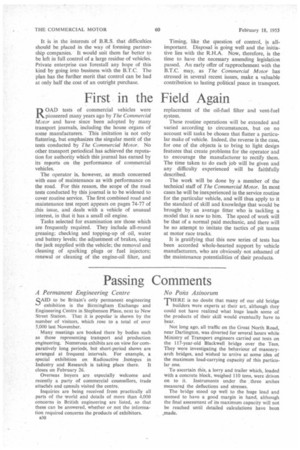First in the Field Again
Page 38

If you've noticed an error in this article please click here to report it so we can fix it.
ROAD tests of commercial vehicles were pioneered many years ago by The Commercial Motor and have since been adopted by many transport journals, including the house organs of some manufacturers. This imitation is not only flattering, but emphasizes the singular merit of the tests conducted by The Commercial Motor. No other transport periodical has achieved the reputation for authority which this journal has earned by its reports on the performance of commercial vehicles.
The operator is, however, as much concerned with ease of maintenance as with performance on the road. For this reason, the scope of the road tests conducted by this journal is to be widened to cover routine service. The first combined road and maintenance test report appears on pages 74-77 of .this issue, and deals with a vehicle of unusual interest, in that it has a small oil engine.
Tasks selected for examination are those which are frequently required. They include all-round greasing; checking and topping-up of oil, water and battery levels; the adjustment of brakes, using the jack supplied with the vehicle; the removal and cleaning of sparking plugs or fuel injectors; renewal or cleaning of the engine-oil filter, and replacement of the oil-fuel filter and vent-fuel system.
These routine operations will be extended and varied according to circumstances, but on no account will tasks be chosen that flatter a particular make of vehicle. Indeed, the reverse is the case, for one of the objects is to bring to light design features that create problems for the operator and to encourage the manufacturer to rectify them. The time taken to do each job will be given and any difficulty experienced will be faithfully described.
The work will be done by a member of the technical staff of The Commercial Motor. In most cases he will be inexperienced in the service routine for the particular vehicle, and will thus apply to it the standard of skill and knowledge that would be brought by an average fitter who is tackling a model that is new to him. The speed of work will be that of a normal paid mechanic, and there will be no attempt to imitate the tactics of pit teams at motor race tracks.
It is gratifying that this new series of tests has been accorded whole-hearted support by vehicle manufacturers, who are obviously not ashamed of the maintenance potentialities of their products.








































































































